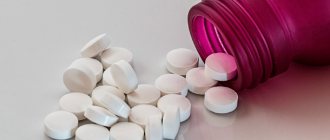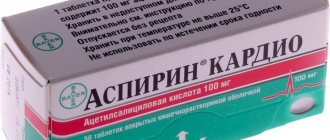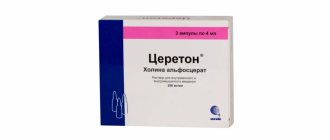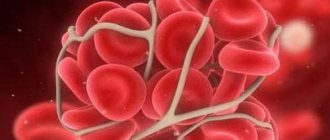Not long ago, our gynecologists attended the XXVI European Congress of Perinatal Medicine (ECPM 2018). We, together with Svetlana Silenko, Deputy Head of the Center for Obstetrics and Gynecology GMS Clinic, decided to share with you the most interesting facts heard and seen at the congress.
National Institute of Health (NICE) guidelines
Aspirin 75 mg is recommended from 12 weeks of pregnancy if there is at least one high risk:
- arterial hypertension in a previous pregnancy;
- chronic renal pathology;
- autoimmune diseases (such as APS);
- diabetes;
- chronic arterial hypertension.
Aspirin 75 mg is recommended from 12 weeks if there are two or more moderate risks:
- first pregnancy;
- age over 40 years;
- the interval between pregnancies is more than 10 years;
- family history of preeclampsia;
- multiple pregnancy;
- BMI>35.
Aspirin cardio, tablets 100 mg, 28 pcs.
Manufacturer
Bayer Pharma AG, Germany
Compound
1 tablet:
- acetylsalicylic acid 100 mg or 300 mg;
Excipients:
cellulose, powder 10 mg or 30 mg,
corn starch 10 mg or 30 mg;
shell:
methacrylic acid and ethyl acrylate copolymer 1:1 (Eudragit L30D) 7.857 mg or 27.709 mg,
polysorbate 80 0.186 mg or 0.514 mg,
sodium lauryl sulfate 0.057 mg or 0.157 mg,
talc 8.100 mg or 22.380 mg,
triethyl citrate 0.800 mg or 2.240 mg.
pharmachologic effect
Pharmgroup:
NSAIDs.
Pharmaceutical action:
The mechanism of the antiplatelet action of acetylsalicylic acid (ASA) is based on the irreversible inhibition of cyclooxygenase (COX-1), as a result of which the synthesis of thromboxane A2 is blocked and platelet aggregation is suppressed.
The antiplatelet effect is most pronounced in platelets, since they are not able to re-synthesize cyclooxygenase. It is believed that ASA has other mechanisms of suppressing platelet aggregation, which expands the scope of its use in various vascular diseases.
ASA also has anti-inflammatory, analgesic and antipyretic effects.
Indications
— Primary prevention of acute myocardial infarction in the presence of risk factors (for example, diabetes mellitus, hyperlipidemia, arterial hypertension, obesity, smoking, old age) and recurrent myocardial infarction; - Unstable angina (including suspicion of acute myocardial infarction) and stable angina; — Prevention of stroke (including in patients with transient cerebrovascular accident); — Prevention of transient cerebrovascular accident; — Prevention of thromboembolism after operations and invasive interventions on vessels (for example, coronary artery bypass grafting, carotid endarterectomy, arteriovenous bypass grafting, angioplasty and stenting of the coronary arteries, carotid angioplasty) — Prevention of deep vein thrombosis and thromboembolism of the pulmonary artery and its branches ( including long-term immobilization as a result of extensive surgery).
Use during pregnancy and breastfeeding
Inhibition of prostaglandin synthesis may have negative effects on pregnancy and embryonic or fetal development. The use of large doses of salicylates (more than 300 mg/day; we are talking about the usual doses of ASA from 500 mg as an anesthetic) in the first trimester of pregnancy is associated with an increased incidence of fetal defects (cleft palate, heart defects). The administration of salicylates in the first trimester of pregnancy is contraindicated.
In the third trimester of pregnancy, salicylates in high doses (more than 300 mg/day; we are talking about usual doses of ASA from 500 mg as an anesthetic) can cause inhibition of labor, premature closure of the ductus arteriosus in the fetus, increased bleeding in the mother and fetus, and administration immediately before birth may cause intracranial hemorrhage, especially in premature infants. The administration of salicylates in the third trimester of pregnancy is contraindicated.
In the second trimester of pregnancy, salicylates can be prescribed only taking into account a strict assessment of the risks and benefits for the mother and fetus, preferably in doses not exceeding 150 mg/day and for a short period of time.
Use during lactation:
Salicylates and their metabolites pass into breast milk in small quantities. Accidental intake of salicylates during lactation is not accompanied by the development of adverse reactions in the child and does not require cessation of breastfeeding. However, with long-term use of the drug or when it is prescribed in a high dose, breastfeeding should be stopped immediately.
Contraindications
- Hypersensitivity to acetylsalicylic acid, excipients in the composition of the drug Aspirin cardio and other NSAIDs - Bronchial asthma induced by taking salicylates and other NSAIDs; combination of bronchial asthma, recurrent polyposis of the nose and paranasal sinuses and intolerance to ASA - Erosive and ulcerative lesions of the gastrointestinal tract (in the acute stage) - Gastrointestinal bleeding - Hemorrhagic diathesis - Combined use with methotrexate at a dose of 15 mg per week or more - Pregnancy (I and III trimester) and lactation period - Childhood and adolescence (up to 18 years) - Severe renal failure (creatinine clearance (CC) less than 30 ml/min.) - Severe liver failure (class B and higher on the Child-Pugh scale ) — Chronic heart failure III-IV functional class according to the NYHA classification
With caution: For gout, hyperuricemia, because ASA in low doses reduces the excretion of uric acid; It should be borne in mind that ASA in low doses can provoke the development of gout in predisposed patients (those with reduced excretion of uric acid)
If you have a history of gastrointestinal ulcers or gastrointestinal bleeding
If liver function is impaired (below class B on the Child-Pugh scale)
In case of impaired renal function (creatinine clearance more than 30 ml/min), as well as in circulatory disorders resulting from atherosclerosis of the renal arteries, congestive heart failure, hypovolemia, extensive surgery, sepsis, cases of massive bleeding, since in all of these cases ASA may increase the risk development of acute renal failure and renal dysfunction.
For bronchial asthma, chronic respiratory diseases, hay fever, nasal polyposis, drug allergies, including NSAIDs (analgesics, anti-inflammatory, antirheumatic drugs)
In the second trimester of pregnancy
In case of proposed surgical intervention (including minor ones, for example, tooth extraction), since ASA may cause a tendency to develop bleeding for several days after taking the drug. When using Aspirin Cardio in combination with the following drugs (see section “Interaction with other drugs” ):
- with methotrexate at a dose of less than 15 mg per week; - with anticoagulant, thrombolytic or other antiplatelet drugs - with NSAIDs and salicylic acid derivatives in high doses; - with digoxin; - with hypoglycemic agents for oral administration (sulfonylurea derivatives) and insulin; - with valproic acid; -with alcohol (alcoholic drinks in particular); - with selective serotonin reuptake inhibitors; - with ibuprofen.
Side effects
From the digestive system: the most common symptoms are nausea, heartburn, vomiting, abdominal pain; rarely - ulcers of the mucous membrane of the stomach and duodenum; very rarely - perforated ulcers of the mucous membrane of the stomach and duodenum, gastrointestinal bleeding (with corresponding clinical symptoms and laboratory changes), transient liver dysfunction with increased activity of “liver” transaminases.
From the hematopoietic system: the administration of ASA is accompanied by an increased risk of bleeding due to the inhibitory effect of ASA on platelet aggregation. An increase in the frequency of perioperative (intra- and postoperative) bleeding, hematomas (bruises), nosebleeds, bleeding gums, and bleeding from the genitourinary tract has been recorded. There have been reports of serious bleeding events, which include gastrointestinal bleeding and cerebral hemorrhage (especially in patients with hypertension who have not achieved blood pressure (BP) targets and/or are receiving concomitant anticoagulant therapy), which in selected cases may be life-threatening in nature (see section “Special instructions”).
Bleeding can lead to the development of acute or chronic posthemorrhagic/iron deficiency anemia (for example, due to hidden bleeding) with corresponding clinical and laboratory signs and symptoms (asthenia, pallor, hypoperfusion).
There are reports of cases of hemolysis and hemolytic anemia in patients with severe forms of glucose-6-phosphate dehydrogenase deficiency.
Allergic reactions: hypersensitivity reactions with corresponding laboratory and clinical manifestations, such as asthmatic syndrome (bronchospasm), mild to moderate reactions of the skin, respiratory tract, gastrointestinal tract and cardiovascular system, including symptoms such as skin rash , skin itching, urticaria, Quincke's edema, rhinitis, swelling of the nasal mucosa, cardiorespiratory distress syndrome, as well as severe reactions, including anaphylactic shock.
From the central nervous system (CNS): there are reports of cases of dizziness, hearing loss, headache, tinnitus, which may be a sign of a drug overdose (see section “Overdose”).
From the urinary system: there are reports of cases of renal dysfunction and acute renal failure.
Interaction
When used simultaneously, ASA enhances the effect of the following drugs; If it is necessary to simultaneously prescribe ASA with the listed drugs, the need to reduce the dose of these drugs should be considered:
-methotrexate by reducing renal clearance and displacing it from protein binding; the combination of ASA with methotrexate is accompanied by an increased incidence of side effects from the hematopoietic organs; the use of Aspirin® Cardio together with methotrexate is contraindicated if the dose of the latter exceeds 15 mg per week (see section “Contraindications”) and can be used with caution at a dose of methotrexate less than 15 mg per week;
heparin and indirect anticoagulants due to disruption of platelet function and displacement of indirect anticoagulants from binding with proteins;
- when used simultaneously with anticoagulants, thrombolytic and antiplatelet agents (ticlopidine), there is an increase in the risk of bleeding as a result of the synergism of the main therapeutic effects of the drugs used;
- when used simultaneously with drugs that have anticoagulant, thrombolytic or antiplatelet effects, an increased damaging effect on the mucous membrane of the gastrointestinal tract is observed;
-selective serotonin reuptake inhibitors, which may lead to an increased risk of bleeding from the upper gastrointestinal tract (synergism with ASA)
-digoxin due to a decrease in its renal excretion, which can lead to its overdose
-hypoglycemic agents for oral administration (sulfonylurea derivatives) and insulin due to the hypoglycemic properties of ASA itself in high doses and displacing sulfonylurea derivatives from association with blood plasma proteins; this must be kept in mind when prescribing ASA to patients with diabetes mellitus receiving the listed medications
- when used simultaneously with valproic acid, its toxicity increases due to displacement from the connection with blood plasma proteins;
-NSAIDs and salicylic acid derivatives in high doses (increased risk of ulcerogenic effect and bleeding from the gastrointestinal tract as a result of synergistic action);
-Ethanol (alcoholic beverages) (increased risk of damage to the mucous membrane of the gastrointestinal tract and prolongation of bleeding time as a result of the mutual enhancement of the effects of ASA and ethanol).
The simultaneous administration of ASA in high doses may weaken the effect of the drugs listed below. If it is necessary to simultaneously prescribe ASA with the listed drugs, you should consider the need to adjust the dose of the drugs listed below:
- any diuretics (when used together with ASA in high doses, a decrease in glomerular filtration rate is observed as a result of a decrease in the synthesis of prostaglandins in the kidneys);
- angiotensin-converting enzyme (ACE) inhibitors (a dose-dependent decrease in glomerular filtration rate (GFR) is noted as a result of inhibition of prostaglandins that have a vasodilatory effect, respectively, a weakening of the hypotensive effect. The clinical significance of the decrease in GFR is noted with a daily dose of ASA more than 160 mg. In addition, there is a decrease in the positive cardioprotective effect of ACE inhibitors prescribed to patients for the treatment of chronic heart failure. This effect is also manifested when used together with ASA in large doses);
- drugs with uricosuric action - benzbromarone, probenecid (reduced uricosuric effect due to competitive suppression of renal tubular excretion of uric acid).
When used simultaneously with ibuprofen, antagonism is observed against the irreversible platelet inhibition caused by the action of ASA, which leads to a decrease in the cardioprotective effects of ASA. Therefore, the combination of ASA with ibuprofen is not recommended in patients with an increased risk of cardiovascular disease.
When used simultaneously with systemic glucocorticosteroids (GCS) (with the exception of hydrocortisone or other GCS used for replacement therapy of Addison's disease), there is an increase in the elimination of salicylates and, accordingly, a weakening of their effect. When using GCS and salicylates in combination, it should be remembered that during treatment the level of salicylates in the blood is reduced, and after discontinuation of GCS, an overdose of salicylates is possible.
How to take, course of administration and dosage
It is advisable to take ASPIRIN CARDIO tablets before meals with plenty of liquid. ASPIRIN CARDIO tablets are taken once a day. ASPIRIN CARDIO is intended for long-term use. The duration of therapy is determined by the doctor.
— Primary prevention of acute myocardial infarction in the presence of risk factors: 100 mg/day or 300 mg every other day.
— Prevention of recurrent infarction, stable and unstable angina: 100-300 mg/day.
- Unstable angina (if the development of acute myocardial infarction is suspected): the initial dose of Aspirin Cardio 100-300 mg (the first tablet must be chewed for faster absorption) should be taken by the patient as soon as possible after the development of acute myocardial infarction is suspected. In the next 30 days after the onset of myocardial infarction, a dose of 200-300 mg/day should be maintained. After 30 days, appropriate therapy should be prescribed to prevent recurrent myocardial infarction.
— Prevention of stroke and transient cerebrovascular accident: 100-300 mg/day.
— Prevention of thromboembolism after operations and invasive interventions on blood vessels: 100-300 mg/day.
— Prevention of deep vein thrombosis and thromboembolism of the pulmonary artery and its branches: 100-200 mg/day or 300 mg every other day.
What to do if you miss one or more doses of the drug:
Take the missed pill as soon as you remember and then continue taking it as usual. To avoid doubling the dose, do not take the missed tablet if it is near the time of your next tablet.
Features of the action of the drug Aspirin Cardio when first taken and when discontinued:
No specific effects of the drug were observed during the first dose or its withdrawal.
Overdose
Salicylate intoxication (develops when taking ASA at a dose of more than 100 mg/kg/day for more than 2 days) can result from prolonged use of toxic doses of the drug as part of improper therapeutic use of the drug (chronic intoxication) or a single accidental or intentional intake of a toxic dose of the drug adults or children (acute intoxication).
Symptoms of chronic intoxication with salicylic acid derivatives are nonspecific and are often difficult to diagnose. Mild intoxication usually develops only after repeated use of large doses of the drug and is manifested by dizziness, tinnitus, hearing loss, increased sweating, nausea and vomiting, headache and confusion. These symptoms disappear after reducing the dose of the drug. Tinnitus may appear when the concentration of ASA in the blood plasma is from 150 to 300 mcg/ml. More severe symptoms appear when plasma ASA concentrations are above 300 mcg/ml.
The main manifestation of acute intoxication is a severe disturbance of the acid-base state, the manifestations of which may vary depending on the age of the patient and the severity of intoxication. In children, the most typical development is metabolic acidosis. Treatment of intoxication is carried out in accordance with accepted standards and depends on the severity of intoxication and the clinical picture and should be aimed mainly at accelerating the elimination of the drug and restoring the water-electrolyte balance and acid-base state.
Mild to moderate overdose symptoms:
Dizziness, tinnitus, hearing impairment, increased sweating, nausea, vomiting, headache, confusion, profuse sweating, tachypnea, hyperventilation, respiratory alkalosis.
Treatment: gastric lavage, repeated intake of activated carbon, forced alkaline diuresis, restoration of water-electrolyte balance and acid-base state.
Symptoms of moderate to severe overdose: - respiratory alkalosis with compensatory metabolic acidosis; - hyperpyrexia (extremely high body temperature); — respiratory disorders: hyperventilation, non-cardiogenic pulmonary edema, respiratory depression, asphyxia; - disorders of the cardiovascular system: cardiac arrhythmias, arterial hypotension, depression of cardiac activity; - disturbances in water and electrolyte balance: dehydration, impaired renal function from oliguria up to the development of renal failure, characterized by hypokalemia, hypernatremia, hyponatremia; - impaired glucose metabolism: hyperglycemia, hypoglycemia (especially in children), ketoacidosis; - tinnitus, deafness; - gastrointestinal bleeding; - hematological disorders: from inhibition of platelet aggregation to coagulopathy, prolongation of prothrombin time, hypoprothrombinemia; - neurological disorders: toxic encephalopathy and depression of central nervous system function (drowsiness, confusion, coma, convulsions).
Treatment: immediate hospitalization in specialized departments for emergency treatment - gastric lavage, repeated intake of activated charcoal, forced alkaline diuresis, hemodialysis, restoration of water-electrolyte balance and acid-base status, symptomatic therapy.
Special instructions
The drug Aspirin Cardio should be used as prescribed by a doctor.
ASA can provoke bronchospasm, as well as cause attacks of bronchial asthma and other hypersensitivity reactions. Risk factors include a history of bronchial asthma, hay fever, nasal polyposis, chronic respiratory diseases, and allergic reactions to other drugs (for example, skin reactions, itching, urticaria).
The inhibitory effect of ASA on platelet aggregation persists for several days after administration, and therefore may increase the risk of bleeding during surgery or in the postoperative period. If it is necessary to absolutely exclude bleeding during surgery, it is necessary, if possible, to completely abandon the use of ASA in the preoperative period.
Exceeding the dose of ASA is associated with a risk of gastrointestinal bleeding.
Overdose is especially dangerous in elderly patients.
In severe forms of glucose-6-phosphate dehydrogenase deficiency, ASA can cause hemolysis and hemolytic anemia. Factors that may increase the risk of hemolysis include fever, acute infections and high doses of the drug.
Impact on the ability to drive a car/moving machinery
Taking Aspirin®Cardio does not affect the ability to drive a car or drive machinery.
Release form
Aspirin cardio tablets, enteric-coated
Storage conditions
At a temperature not exceeding 25 °C
Best before date
5 years
Active substance
Acetylsalicylic acid
Dosage form
pills
Purpose
For adults, Pregnant women only in the second trimester as prescribed by a doctor
Indications
Prevention of heart attacks and strokes, Prevention of thrombosis, cerebrovascular accident, Angina pectoris
Information in the State Register of Medicines
Go
Barcode and weight
Barcode: 4008500130407 Weight: 0.013 kg
Recommendations of the International Federation of Gynecology and Obstetrics
Women at risk should start taking aspirin 75-150 mg as soon as possible from at least 12 weeks (up to 16 weeks) and continue until 37 weeks of pregnancy or two weeks before an earlier planned birth.
Take at night, as it has been found to be more effective when taken this way. Monitoring platelet levels or bleeding time is not advisable unless there are complaints of any bleeding. In these cases, aspirin is discontinued.
Enteric forms are used if there is a history of indications of a gastric ulcer. Low doses of Aspirin were not associated with a higher risk of bleeding and do not affect the tactics of delivery, labor management, or the choice of pain relief method
The recommended dose of aspirin by professional societies is 75-80 mg per day, but a recent meta-analysis suggests that the dose of aspirin should be 100 mg or more per day, and started before 16 weeks of gestation. Therapy should be completed at 36 weeks or if labor begins.
Triple effect
How did it happen that a medicine with a triple effect - analgesic, antipyretic and anti-inflammatory - became the best friend of heart patients? Aspirin was created in 1897 in Germany, and it was a new word in the treatment of rheumatism. Its triple effect was ideal for this disease. Naturally, the drug was used for various pains, high fevers and colds.
Related article The era of aspirin: the history of the creation of a drug for pain, fever and cancer Everything changed in 1971, when the English pharmacologist
John Vane deciphered the mechanism of action of aspirin. Before this, the drug was like a “black box”: its three effects were known, but it was not clear how it did it. Professor Wayne has proven that aspirin inhibits the synthesis of prostaglandins (PGs), which are widely involved in inflammation, pain and temperature regulation, and also, which is especially important for heart patients, in blood clotting.
How do you know that the benefits outweigh the harm?
The doctor, with your help, will collect and analyze many factors and then make a decision. You yourself can try to assess your risks using an online calculator developed by American cardiologists.
Remember that arterial hypertension itself is not an indication for prescribing aspirin if the patient does not have a diagnosis of coronary heart or brain disease! On the contrary, poorly controlled, high blood pressure is often a contraindication to the use of aspirin, since sudden increases in blood pressure increase the risk of intracerebral bleeding, and aspirin can significantly increase it.
In addition, aspirin may reduce the effectiveness of some drugs used to treat hypertension, such as enalapril, captopril, lisinopril, perindopril, and beta blockers.
If taking preventative aspirin turns out to be unreasonably dangerous for you, your doctor will suggest other prevention options, such as lifestyle changes or taking statins.
Currently commercially available are predominantly low-dose enteric-coated aspirin tablets. The outer shell “dissolves” only in the small intestine, protecting the stomach from irritation. These tablets must be swallowed whole without chewing.
There are also combination preparations containing the additive magnesium hydroxide. It is believed that magnesium in this combination reduces the harmful effects of acetylsalicylic acid on the mucous membrane of the stomach and intestines.
And don't use aspirin if the tablets smell strongly of vinegar—the medicine has probably gone bad!
In order for aspirin to effectively protect your blood vessels, it is prescribed for daily long-term, usually lifelong use. Most likely, you will not feel any changes in your body after starting treatment - but this does not mean that aspirin does not work!








